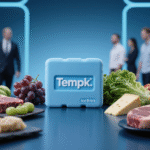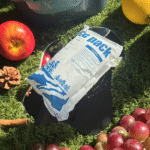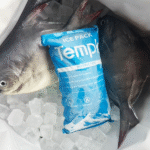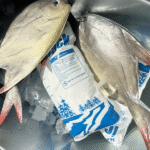¿Cuál es el hielo seco máximo permitido por paquete??
El hielo seco máximo permitido por paquete Depende del modo y del operador.: la carga aérea generalmente permite 200 kilos bajo IATA PI 954, el equipaje de los pasajeros permite 2.5 kilos, y tapones de aire domésticos de USPS 5 lb. Mantendrá el cumplimiento ventilando CO₂, calificación UN1845, e indicando el peso neto en kilogramos. Esta guía te ofrece reglas simples, una calculadora, y listas de verificación de embalaje para evitar rechazos y mantener los productos seguros.
-
Límites rápidos: El hielo seco máximo permitido por paquete por carga aérea, equipaje de pasajeros, USPS, y tierra.
-
Conceptos básicos de cumplimiento: Etiqueta, marcas, y ventilación que pasan los controles de aceptación.
-
Calculadora: Convierta hielo seco en gas CO₂ y paquetes del tamaño adecuado para su ruta y tiempo de espera.
-
Matices del portador: Cuándo los operadores bajan el techo y cómo planificarlo.
-
Consejos del mundo real: kits de vacunas, mariscos, y escenarios de comercio electrónico que realizan envíos limpios.
¿Cómo se establece el hielo seco máximo permitido por paquete en 2025?
Respuesta corta: Carga aérea Los paquetes generalmente se limitan a 200 kilos Bajo Pi 954; equipaje de pasajeros es 2.5 kilos (5.5 lb) por persona/paquete con aprobación de la aerolínea; Servicio aéreo nacional de USPS es ≤5 lb por correo; suelo sigue 49 Excepciones del CFR y reglas del operador. Desfogue, Marcado “UN1845”, Kg neto, y clase 9 etiquetas no son negociables.
El hielo seco máximo permitido por paquete refleja seguridad en espacios cerrados. El hielo seco se sublima en CO₂; En las bodegas de los aviones, esto puede desplazar el oxígeno y aumentar la presión.. Por lo tanto, los operadores imponen límites por paquete y, a veces, totales por vuelo.. Las redes terrestres dependen de la ventilación y el marcado en lugar de un único número nacional. Confirme siempre las variaciones del operador antes de empacar.
Aquí está Pi 954: hielo seco máximo permitido por paquete para carga aérea
Bajo PI 954, puedes cargar hasta 200 kilos por paquete al empaquetar libera CO₂, es fuerte, y es correctamente etiquetado. Las aerolíneas podrán fijar un techo más bajo por avión o ruta. para equipaje, el 2.5 kilos El límite personal protege a los pasajeros y a la tripulación.. El correo aéreo nacional de USPS limita el hielo seco en 5 lb por pieza; cantidades más grandes deben ir superficie/suelo.
| 2025 límites rápidos por modo | Tapa estándar | Cumplimiento del núcleo | Lo que significa para ti |
|---|---|---|---|
| Carga aérea (PI 954) | 200 kilos | Envasado ventilado; UN1845; Clase 9; neto kilos | Diseñar remitente y AWB a PI 954; verificar las tapas del operador |
| Equipaje de pasajeros | 2.5 kilos páginas | Aprobación de aerolínea; ventilado; marca “Hielo seco” y peso | Sólo pequeños artículos personales perecederos |
| Servicio aéreo nacional de USPS | 5 lb | Pub 52 normas; desfogue; marcas | Mantenga los envíos postales de ≤5 lb o cambie a tierra |
| A NOSOTROS. suelo (49 CFR) | Excepción ≤2.5 kilos; >2.5 kg permitidos con reglas adicionales | Ventilado; marcas; aceptación del transportista | Flexible pero aún regulado, especialmente en furgonetas cerradas |
Consejos prácticos y sugerencias.
-
kit farmacéutico (36–72 h): Utilice remitentes VIP; apunte de 10 a 20 kg por paquete, muy por debajo del hielo seco máximo permitido por paquete pero duradero.
-
Alimentos congelados de comercio electrónico (48 h): Elija un servicio más rápido + EPS más grueso para permanecer bajo USPS 5 lb gorro de aire.
-
Viaje de pasajeros (mariscos/medicamentos): Embalar ≤2,5 kilogramos en un refrigerador ventilado; declarar en el check‑in.
Caso en punto: Un carril de vacunas redujo los rechazos al cambiar a PI preimpreso 954 etiquetas y registro Kg neto en el AWB. Se redujo el tiempo de aceptación, y las excursiones frías cayeron en el mes más caluroso de la ruta.
¿Cómo se calcula de forma segura el hielo seco máximo permitido por paquete??
Idea central: 1 kilos hielo seco → ~541 litros de CO₂ en STP. Hielo seco del tamaño adecuado para que el gas esperado se ajuste a la capacidad de ventilación de su paquete y al límite por paquete del operador. El hielo seco máximo permitido por paquete nunca debe exceder ni la capacidad de ventilación ni el límite máximo reglamentario..
Utilice este sencillo método de dos pasos desde la perspectiva del transportista. Mantenga las oraciones cortas. Usa números redondos.
-
Estimar el volumen de gas:
dry ice (kg) × 541 = CO₂ liters. -
Comprobar la ventilación: Su embalaje debe aliviar ese gas de forma segura durante el viaje.. Si no, reducir el hielo seco o mejorar el aislamiento.
Ventilación de co₂, etiquetado, y documentación detrás del límite
-
Desfogue: Nunca selle los revestimientos herméticamente. Las tapas deben levantar o ventilar.
-
Calificación: Imprimir "Dióxido de carbono, sólido (hielo seco), ONU1845” y Kg neto en la caja exterior.
-
Etiqueta: Aplicar Clase 9 Diamante de peligro; mantener el kg netos fuera el borde del diamante.
-
Documento: Para carga aérea, incluir UN1845 y Kg neto en la carta de porte aéreo. Algunos casos requieren una declaración de la DG.
| que imprimir | Detalle mínimo | Colocación | Por qué te importa |
|---|---|---|---|
| Nombre de envío adecuado | "Dióxido de carbono, sólido "o" hielo seco " | Lado de la dirección | Identificación universal |
| Número de la ONU | UN1845 | con el nombre | El control de aceptación pasa más rápido |
| Cantidad neta | solo kg (no libras) | Dirección cercana; afuera etiqueta de peligro | Evita retrasos en el reetiquetado |
| etiqueta de clase | Clase 9 diamante | Departamento, superficie limpia | Señal visual para los manejadores |
Qué transportistas y servicios modifican el hielo seco máximo permitido por bulto?
Aerolíneas e integradores puede establecer más bajo mayúsculas que PI 954. Esperar 2.5–10 kg Límites en algunas redes exprés para servicios aéreos de paquetería estándar.. Equipaje de pasajeros se mantiene en 2.5 kilos por persona/paquete con aprobación de la aerolínea. USPS tapa 5 lb por aire doméstico; las piezas más pesadas deben moverse superficie/suelo con la marca "Surface Mail Only". Suelo los transportistas llevarán >2.5 kg por paquete según reglas adicionales: primero confirme la aceptación.
USPS, equipaje de pasajeros, y excepciones terrestres: cómo planificar
-
Aire de USPS (≤5 lb): Mejore el aislamiento o reduzca el tiempo de tránsito para permanecer debajo de la tapa.
-
Pasajero (2.5 kilos): Declarar, marca, y use contenedores ventilados. Para más volumen, carga del barco.
-
Suelo >2.5 kilos: Aplique marcas completas y garantice la conciencia del conductor en vehículos cerrados..
2025 Desarrollos y tendencias que configuran el máximo de hielo seco permitido por paquete.
Descripción general de la tendencia: En 2025, Los programas de cadena de frío se centran en óptimo—no máximo—hielo seco. Elegante Sensores de CO₂, ventilación automatizada, y PCM híbrido + hielo seco Los paquetes reducen el riesgo., eventos de re-hielo, y emisiones. Los operadores están apretando CO₂ por vuelo Planificación de carga en temporadas cálidas y rutas de transporte de animales.. Actualice los SOP con formatos de etiquetas actuales y letras más grandes para Kg neto legibilidad.
Qué hay de nuevo (de un vistazo)
-
Monitoreo inteligente de CO₂: Gas en tiempo real + Las alertas de temperatura reducen los rechazos sorpresa..
-
Paquetes híbridos: PCM + hielo seco modesto extiende el tiempo de espera con menos CO₂ total.
-
Aceptación UX: Los transportistas enfatizan los controles de cantidad previos a la reserva y la colocación clara de etiquetas.
Insight del mercado: Los productos biológicos y las terapias genéticas mantienen alta la demanda. Los sistemas VIP reutilizables y los paquetes de rutas específicas reducen el hielo seco total y mantienen los carriles congelados. Equipos que modelan la sublimación contra por retención Los límites evitan divisiones y retrasos de último momento..
Preguntas frecuentes
Q1. ¿Cuál es el hielo seco máximo permitido por paquete en carga aérea??
Típicamente 200 kilos Bajo Pi 954, pero los operadores pueden establecer números más bajos. Reserva con antelación y confirma.
Q2. ¿Cuál es el hielo seco máximo permitido por bulto en el equipaje de los pasajeros??
2.5 kilos (5.5 lb) por persona/paquete con aprobación de la aerolínea en un ventilado recipiente.
Q3. ¿Cuál es el hielo seco máximo permitido por paquete en el aire nacional de USPS??
5 lb por correo. Las piezas más pesadas deben viajar superficie/suelo y ser marcado en consecuencia.
Q4. ¿Puedo exceder 2.5 kg en el suelo?
Sí, pero pierde la excepción de pequeñas cantidades y debe cumplir con reglas adicionales sobre materiales peligrosos y transportistas..
Q5. ¿Dónde escribo el peso neto??
En la caja exterior en kilogramos, no dentro de la clase 9 diamante.
Q6. se forma (pellets versus bloques) cambiar el hielo seco máximo permitido por paquete?
No, el límite es masa neta. Los gránulos subliman más rápido, así que planifique cargas ligeramente más altas para el mismo tiempo de espera.
P7. ¿Necesito la declaración de un remitente??
A veces. Para productos sin DG enfriados con hielo seco, a menudo solo anota UN1845 y kg netos en el AWB. Consulta las normas de tu operador.
Resumen y recomendaciones
Puntos clave: El hielo seco máximo permitido por paquete es 200 kilos para carga aérea (típicamente), 2.5 kilos para equipaje de pasajeros, y 5 lb para aire USPS. Siempre ventile el CO₂, marca UN1845 y Kg neto, y confirmar variaciones del operador. Utilice paquetes VIP o híbridos para reducir la masa requerida y mantenerse muy por debajo de los límites.
Siguientes pasos:
-
Mapea tu modo y ruta; aplicar la tapa correcta.
-
Utilice el estimador anterior para dimensionar el hielo seco y validar la ventilación..
-
Imprima etiquetas compatibles y cantidades previas a la reserva con el transportista.
-
Agregue registros de temperatura y CO₂ a cada carril de alto valor.
CTA: Necesita un juego de etiquetas listo para PI‑954 y una lista de verificación de embalaje? Habla con Tempk hoy.
Acerca de Tempk
Diseñamos y validamos Cumple con IATA Sistemas de hielo seco y PCM para biofarmacia, alimento, y logística especializada. Nuestros ingenieros combinan la ciencia del embalaje con el conocimiento de aceptación de las aerolíneas para reducir los rechazos y los costos de recongelación.. Los clientes ven menos retrasos y temperaturas más estables gracias al hielo seco del tamaño adecuado y una mejor ventilación.
Optimicemos tu ruta: Solicitar un carril específico plantilla de embalaje y etiquetado de nuestro equipo.
























